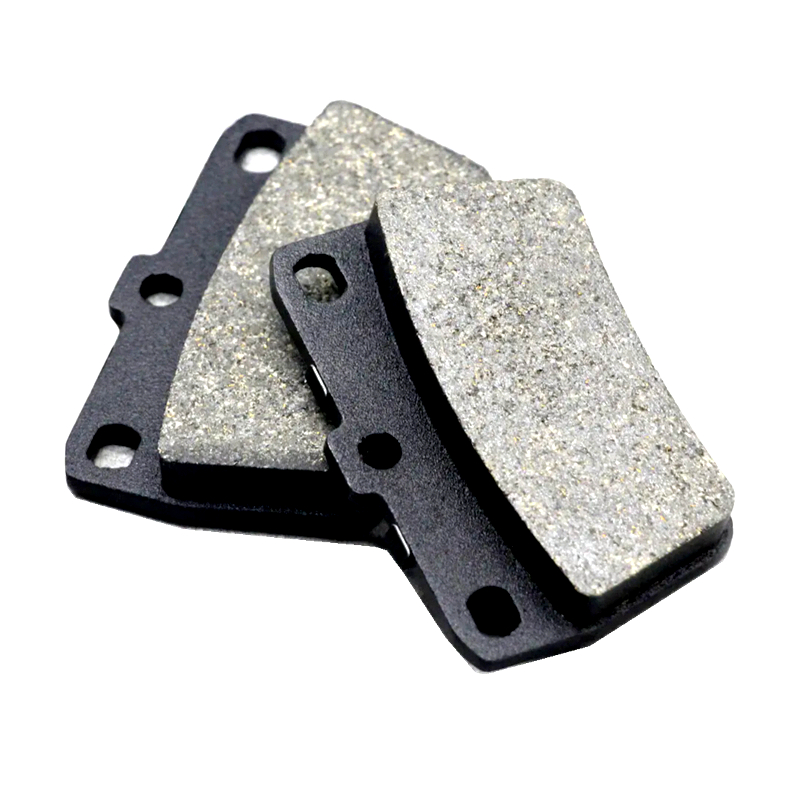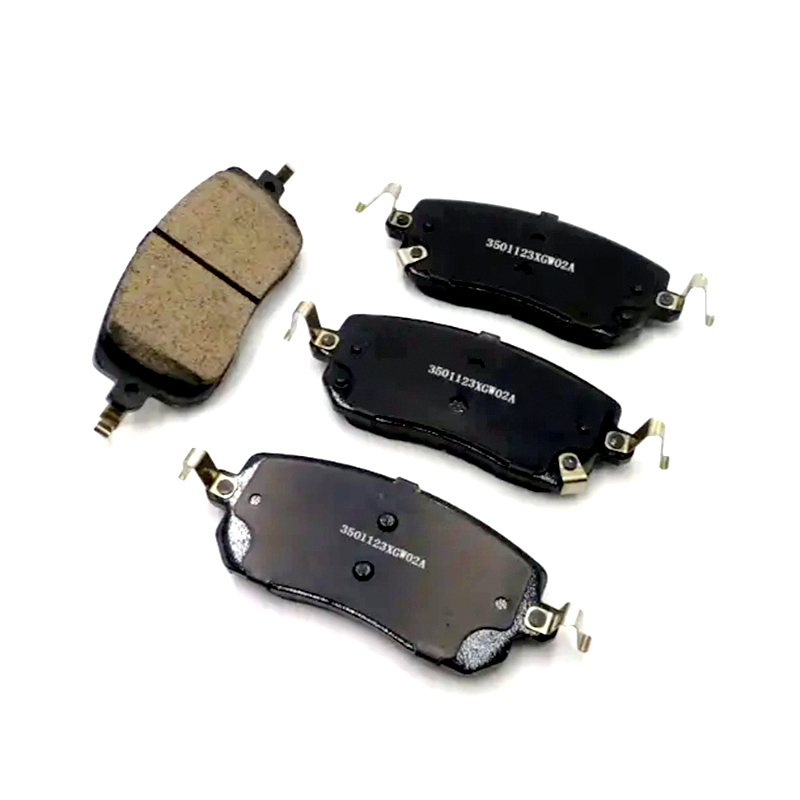Views: 0 Author: Site Editor Publish Time: 2025-04-09 Origin: Site








Choosing the right brake pads for your truck is essential for safety and performance. The wrong pads can impact braking power, especially when towing or hauling heavy loads. In this post, we’ll discuss the best brake pads for trucks and help you understand how to select the right ones based on your vehicle’s needs.
Brake pads are a key component of a truck’s braking system. They press against the rotors to slow or stop the vehicle. This process generates friction, which creates heat. In trucks, the right brake pads are crucial because these vehicles often carry heavy loads or tow trailers, which can increase the braking demand. Without the correct brake pads, stopping power could be compromised, leading to unsafe driving conditions.
The interaction between the brake pads and the rotors is what makes braking possible. When you press the brake pedal, the pads clamp onto the rotors, creating friction that slows the wheels. For trucks, which regularly face higher demands, brake pads need to handle more stress. The performance of brake pads can vary based on load weight, towing, and even the terrain you drive on.
Ceramic brake pads are made from ceramic materials mixed with copper fibers. These pads are known for their durability and low dust production. They offer smooth and quiet braking performance, making them ideal for trucks that do not face extreme towing or heavy loads on a regular basis. They are also highly resistant to heat, which improves their performance and lifespan. However, they may not perform as well under heavy stress compared to semi-metallic pads.
Semi-metallic pads are made from a mix of metal and other materials. They are excellent at handling high heat and pressure, making them a great choice for trucks that tow or carry heavy loads. These pads provide better stopping power than ceramic pads and are often more affordable. However, they may produce more noise and dust. Their strength comes at the cost of slightly faster wear on the rotors.
Organic brake pads are made from materials like rubber, carbon, and resins. They are the least expensive option and are very gentle on rotors. These pads are suitable for light-duty trucks that aren’t used for heavy towing or high-stress driving. While they are quieter and produce less dust, they don’t perform as well in extreme conditions and have a shorter lifespan compared to ceramic or semi-metallic pads.
Each type of brake pad has its own strengths and weaknesses, depending on the truck’s usage and performance needs. Understanding these differences can help you make an informed decision when it’s time to replace or upgrade your truck’s brake pads.

Brake pads play a vital role in the performance of trucks that tow or carry heavy loads. When a truck is loaded or towing, the brake system must work harder to stop the vehicle. The added weight increases the force needed to slow down, placing more strain on the brake pads. This can lead to faster wear and reduced braking efficiency.
Trucks that regularly tow trailers or haul heavy loads need specialized brake pads. Standard brake pads might not provide enough stopping power under such conditions. Heavy-duty pads, such as semi-metallic or performance brake pads, can better handle the increased braking demands. These pads are designed to handle the heat and stress that comes with towing, ensuring your truck stops safely.
Heat resistance is crucial for brake pads, especially when a truck is under heavy load. When braking, friction generates heat, and when a truck is towing or carrying a heavy load, this heat builds up much faster. If the brake pads can't handle the heat, they may lose their effectiveness, leading to brake fade or even failure.
For trucks that frequently operate under heavy loads or tow trailers, ceramic and semi-metallic brake pads are excellent choices. Ceramic pads are known for their heat resistance and longer lifespan, while semi-metallic pads excel in high-heat situations due to their metal content. Both options help prevent overheating, keeping your brakes functional even in tough conditions.
The lifespan of truck brake pads depends on several factors, including driving conditions and the amount of weight the truck carries. On average, truck brake pads should last anywhere from 30,000 to 70,000 miles, but this can vary greatly depending on use.
If you often drive in stop-and-go traffic, tow heavy loads, or drive on steep inclines, your brake pads may wear out faster. It’s important to monitor your brake performance. If you notice longer stopping distances, squeaking noises, or vibration, it’s time to check your pads. Regular inspections can help you avoid dangerous situations caused by worn-out brake pads.
Ceramic brake pads are a popular choice for trucks due to their many benefits. They are known for their long lifespan, low dust production, and quieter operation. Ceramic pads also provide smooth and consistent braking performance, making them a great option for everyday driving and light towing.
However, ceramic pads have some limitations. They are not ideal for extremely heavy-duty applications or off-road driving. Under these conditions, they may not perform as well, as they can't handle the extreme heat and stress generated by heavy loads or challenging terrains. Despite this, for regular use, they are a solid choice for most trucks.
Semi-metallic brake pads are made from a mixture of metal and other materials. They are known for their durability and heat resistance, which makes them a great choice for trucks that haul heavy loads or need consistent performance under demanding conditions. These pads perform well in high-heat situations and offer strong stopping power, even under heavy stress.
However, semi-metallic pads come with a few downsides. They can be noisy compared to ceramic pads, and their use can lead to increased rotor wear. If you drive your truck in tough conditions, such as frequent towing or off-roading, semi-metallic pads might be the best option for you.
Organic brake pads are made from materials like rubber, carbon, and resins. These pads are quiet, gentle on rotors, and tend to be more affordable. They work well for light-duty trucks that don't carry heavy loads or tow frequently.
However, organic brake pads have some drawbacks. They tend to wear out faster than ceramic or semi-metallic pads and aren't as heat-resistant. This makes them less suitable for heavy-duty trucks or those used for towing. If you don't put your truck under heavy stress, organic pads can be a good option due to their lower cost and quiet operation.

A performance brake kit is a complete upgrade designed to improve your truck’s braking power. These kits typically include high-quality components such as carbon-fiber ceramic brake pads and drilled & slotted rotors. The carbon-fiber ceramic pads offer excellent stopping power while generating less dust and noise, making them ideal for trucks that tow or carry heavy loads.
Drilled and slotted rotors help reduce heat buildup during braking, ensuring better performance under heavy stress. They allow for improved airflow and provide a cleaner contact patch between the pads and rotors. These upgrades are perfect for trucks that experience high braking demands, such as towing or off-roading.
Upgrading to a performance brake kit gives your truck better stopping power, especially under heavy loads. The stronger braking force helps prevent accidents and ensures your truck can handle intense driving situations.
Performance kits also extend the lifespan of your brakes. The improved design of the rotors and pads reduces heat buildup, which in turn minimizes wear and tear. Additionally, the upgraded components help reduce vibration, making for a smoother and safer ride, even during long hauls or when towing large loads.
For trucks that frequently tow or carry heavy weights, upgrading to a performance brake kit significantly improves safety and overall performance. It ensures your truck can stop efficiently, even in demanding conditions.
The first step in choosing the right brake pads is understanding your truck's towing capacity and load requirements. Trucks that carry heavy loads or tow trailers require stronger brake pads. To determine your truck's capacity, check your owner’s manual or look for a label inside the driver-side door that lists the towing capacity. If your truck is often used for heavy hauling, consider upgrading to pads designed for heavy-duty use, such as semi-metallic or performance brake pads.
Next, think about your typical driving conditions. Do you mostly drive in the city, with frequent stops, or do you travel long distances on highways? For urban driving, pads that offer smooth and quiet operation, like ceramic pads, may be ideal. However, if you often drive off-road or tow heavy loads, you’ll need more durable pads that can handle heat and friction, such as semi-metallic or high-performance options.
Brake pads come in several materials, each suited for different needs. Ceramic pads offer excellent longevity, low dust, and quiet performance, making them great for regular driving. If you need heat resistance and high performance, semi-metallic pads are a better choice, especially for trucks that tow or carry heavy loads. Organic pads are a budget-friendly option but may not offer the heat resistance needed for demanding driving conditions.
If you tow frequently or have a truck that’s used for heavy hauling, consider upgrading to a performance brake kit. These kits usually include high-quality carbon-fiber ceramic pads and drilled & slotted rotors, providing superior stopping power. They are designed to handle the increased stress from towing and prevent heat buildup, making them a great choice for improving safety and performance.
Worn brake pads can show several signs. If you hear squeaking or squealing when braking, it could indicate that your pads are too thin. Another common symptom is reduced stopping power. If your truck takes longer to stop, it’s a sign the pads are worn out. Vibration or pulsation in the brake pedal is another clear sign of brake pad wear.
To inspect your truck’s brake pads, you can visually check their thickness. If the pads are less than a quarter-inch thick, it’s time for a replacement. Also, examine the rotors for grooves or scoring, which could indicate further damage that needs attention.
Driving with worn-out brake pads is dangerous. As the pads wear down, they lose their ability to provide sufficient stopping power, which can lead to accidents. If the pads wear too thin, they can damage the rotors, causing costly repairs. Additionally, reduced braking efficiency makes it harder to stop the truck safely, especially under heavy loads.
Regular brake maintenance is essential to ensure safety. Check your brake pads periodically and replace them as needed to avoid serious issues.
Choosing the right brake pads is crucial for truck safety, especially when towing, hauling, or off-roading. Ceramic pads are ideal for everyday use, while semi-metallic pads are best for heavy-duty tasks. Organic pads work well for light-duty trucks. Always prioritize safety and performance when upgrading or replacing brake pads to ensure reliable braking power.
A: Brake pads should typically be replaced every 30,000 to 70,000 miles, depending on driving conditions and load. Trucks that tow or carry heavy loads may require more frequent replacement.
A: Yes, you can upgrade brake pads without replacing rotors, but it's important to inspect the rotors for wear. If the rotors are damaged or worn, replacing them is recommended for optimal performance.
A: Yes, performance brake kits are worth it for trucks that tow or haul heavy loads. They improve stopping power, reduce heat buildup, and enhance safety.
